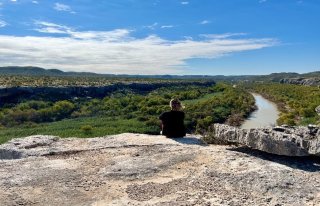US-Mexico Border 2025 Program: Celebrating Hispanic Heritage Month
As a Fronteriza (someone who grew up along the border), environmental injustices have shaped my academic path as I finish my master’s in occupational and environmental health. Growing up between two countries, I realized how important it was to have cooperation between the U.S. and Mexico as we share not only the people and culture, but also the land, air, and water sheds.
September 15 to October 15 is National Hispanic Heritage Month, which provides an opportunity to celebrate the 60 million Hispanics and Latino Americans’ stories, contributions, and achievements. It is important that we not only celebrate Hispanics and Latino Americans, but also recognize the unique public health and environmental issues they may face.
EPA is committed to Environmental Justice, which is the fair treatment and meaningful involvement of all people regardless of race, color, national origin, or income with respect to the development, implementation, and enforcement of environmental laws, regulations, and policies.

The Border 2025 program is the latest environmental program implemented under the 1983 La Paz Agreement. It builds on the Border 2012 and Border 2020 environmental programs, emphasizing regional, community-led approaches for decision making, priority setting, and project implementation to address the environmental and public health problems in the US-Mexico border region.
The Border 2025 Program encourages meaningful participation from communities and local partners and covers the border from California to Texas. This program is an important example of how EPA and others work alongside their Mexican counterparts to achieve environmental and public health goals benefitting millions of Mexicans and Americans along the border.
Learn more about the Border 2025 Program

About the Author
Giovanna Olivares-McLaughlin
Student Trainee
Region 6
Giovanna Olivares-McLaughlin is a first generation Mexican-American from the San Diego, CA- Tijuana, Baja California region. She is a Biological Science Student Trainee for EPA Region 6, El Paso Border Office as she finishes her Master's in Public Health in Occupational and Environmental Health. She graduated from the University of California San Diego with a Bachelor's in Public Health and a minor in Frenc h Literature in 2020. She is passionate about environmental issues along the US-MX Border.
Editor’s Note: The views expressed here are intended to explain EPA policy. They do not change anyone’s rights or obligations. You may share this article. However, please do not change the title or the content, or remove EPA’s identity as the author. If you do make substantive changes, please do not attribute the edited title or content to EPA or the author.
EPA’s official web site is www.epa.gov. Some links on this page may redirect users from the EPA website to specific content on a non-EPA, third-party site. In doing so, EPA is directing you only to the specific content referenced at the time of publication, not to any other content that may appear on the same webpage or elsewhere on the third-party site, or be added at a later date.
EPA is providing this link for informational purposes only. EPA cannot attest to the accuracy of non-EPA information provided by any third-party sites or any other linked site. EPA does not endorse any non-government websites, companies, internet applications or any policies or information expressed therein.
